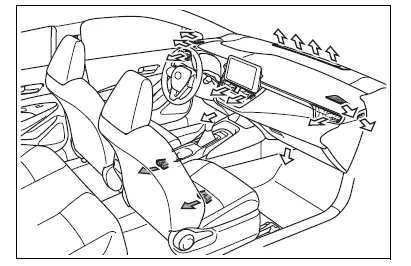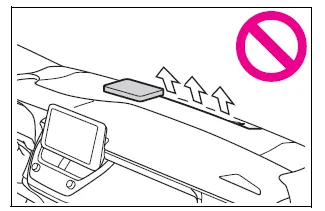Toyota Corolla (E210) 2019-2025 Owners Manual / Interior features / Using the air conditioning system and defogger / Manual air conditioning system
Toyota Corolla (E210): Manual air conditioning system
Air conditioning controls
The display and button positions will differ depending on the type of the system.

- Fan speed control switch
- Temperature control switch
- "MAX A/C" switch
- "A/C" switch
- Outside air mode switch
- Recirculated air mode switch
- Airflow mode control switch
- Rear window defogger and outside rear view mirror defoggers switch*
- Windshield defogger switch
- On/off switch
- Rear window defogger switch*
*: If equipped
■ Adjusting the temperature setting
To adjust the temperature setting, turn the temperature control switch clockwise (warm) or counterclockwise (cool).
If "A/C" switch is not pressed, the system will blow ambient temperature air or heated air.
For quick cooling, press the "MAX
A/C" switch. The air conditioning
will automatically turn on and, if an air outlet position
 or
or
 is
selected, the system will be set to
recirculated air mode. While "MAX
A/C" is selected, it is not possible to
turn off the air conditioning.
is
selected, the system will be set to
recirculated air mode. While "MAX
A/C" is selected, it is not possible to
turn off the air conditioning.
■ Fan speed setting
To adjust the fan speed, turn the fan speed control switch clockwise (increase) or counterclockwise (decrease).
Pressing the on/off switch to turns off the fan.
When the fan is off, pressing the on/off switch or turning the fan speed control switch clockwise will turn on the fan.
■ Change the airflow mode
Press the airflow mode control switch.
The airflow mode changes as follows each time the switch is pressed.

- Upper body
- Upper body and feet
- Feet
- Feet and the windshield defogger operates
■ Switching between outside air and recirculated air modes
- To change to recirculated air mode, press the recirculated air mode switch.
The indicator illuminates on the recirculated air mode switch.
- To change to outside air mode, press the outside air mode switch.
The indicator illuminates on the outside air mode switch.
■ Set cooling and dehumidification function
Press the "A/C" switch.
When the function is on, the indicator illuminates on the "A/C" switch.
■ Defogging the windshield
Defoggers are used to defog the windshield and front side windows.
Press the windshield defogger switch.
Set the outside/recirculated air mode switch to outside air mode if the recirculated air mode is used.
To defog the windshield and the side windows quickly, turn the air flow and temperature up.
To return to the previous mode, press the windshield defogger switch again when the windshield is defogged.
When the windshield defogger switch is on, the indicator illuminates on the windshield defogger switch.
■ Defogging the rear window and outside rear view mirrors
Vehicles without outside rear view mirror defoggers
A defogger is used to defog the rear window.
Press the rear window defogger switch.
The defogger will automatically turn off after a while.
When the rear window defogger switch is on, the indicator illuminates on the rear window defogger switch.
Vehicles with outside rear view mirror defoggers
Defoggers are used to defog the rear window, and to remove raindrops, dew and frost from the outside rear view mirrors.
Press the rear window and outside rear view mirror defoggers switch.
The defoggers will automatically turn off after a while.
When the rear window and outside rear view mirror defoggers switch is on, the indicator illuminates on the rear window and outside rear view mirror defoggers switch.
■Fogging up of the windows
- The windows will easily fog up when the humidity in the vehicle is high. Turning "A/C" switch is on will dehumidify the air from the outlets and defog the windshield effectively.
- If you turn "A/C" switch is off, the windows may fog up more easily.
- The windows may fog up if the recirculated air mode is used
■When driving on dusty roads
Close all windows. If dust thrown up by the vehicle is still drawn into the vehicle after closing the windows, it is recommended that the air intake mode be set to outside air mode and the fan speed to any setting except off.
■Outside/recirculated air mode
Setting to the recirculated air mode temporarily is recommended in preventing dirty air from entering the vehicle interior and helping to cool the vehicle when the outside air temperature is high.
■When the outside temperature falls to nearly 32ºF (0ºC)
The dehumidification function may not operate even when "A/C" switch is pressed.
■Ventilation and air conditioning odors
- To let fresh air in, set the air conditioning system to the outside air mode.
- During use, various odors from inside and outside the vehicle may enter into and accumulate in the air conditioning system. This may then cause odor to be emitted from the vents.
- It is recommended that the air conditioning system be set to outside air mode prior to turning the vehicle off.
- When parking, the system automatically switches to outside air mode to encourage better air circulation throughout the vehicle, helping to reduce odors that occur when starting the vehicle.
■Air conditioning system refrigerant
- A label regarding the refrigerant of the air conditioning system is attached to the engine compartment at the location shown in the following illustration.

- The meaning of each symbol on the label are as follows:
 Caution
Caution
 Air conditioning system
Air conditioning system
 Air conditioning system
lubricant type
Air conditioning system
lubricant type
 Requires registered
technician to service
air conditioning system
Requires registered
technician to service
air conditioning system
 Flammable refrigerant
Flammable refrigerant
WARNING
■To prevent the windshield from fogging up
Do not use the windshield defogger switch during cool air operation in extremely humid weather.
The difference between the temperature of the outside air and that of the windshield can cause the outer surface of the windshield to fog up, blocking your vision.
■When the outside rear view mirror defoggers are operating (if equipped)
Do not touch the outside rear view mirror surfaces, as they can become very hot and burn you.
NOTICE
■To prevent battery discharge
Do not leave the air conditioning system on longer than necessary when the engine is off.
■When repairing/replacing parts of the air conditioning system
Have repair/replacement performed by your Toyota dealer.
When a part of the air conditioning system, such as the evaporator, is to be replaced, it must be replaced with a new one.
Air outlet layout and operations
■ Location of air outlets
The air outlets and air volume changes according to the selected air flow mode.

 : If equipped
: If equipped
■ Adjusting the position of and opening and closing the air outlets
Front center

Direct air flow to the left or right, up or down
Front right-hand side

Direct air flow to the left or right, up or down
Front left-hand side

Direct air flow to the left or right, up or down
WARNING
■To prevent the windshield defogger from operating improperly
Do not place anything on the instrument panel which may cover the air outlets. Otherwise, air flow may be obstructed, preventing the windshield defoggers from defogging.

Other materials:
Wiper rubber lh
Replacement
1. Remove fr wiper blade lh
remove the front wiper blade lh from the front wiper arm lh.
Notice:
do not fold down the front wiper arm with the front wiper blade being removed
from it.
2. Remove wiper rubber lh
remove the front wiper rubber lh from the front wi ...
Center stop lamp assy
Replacement
1. Remove package tray trim panel assy (w/o rear spoiler)
2. Remove center stop lamp assy (w/o rear
spoiler)
Remove the center stop light assy as shown in the illustlation.
3. Remove center stop lamp assy (w/ rear
spoiler)
Remove the 2 screws.
disconnect th ...
Display and menu icons
■ Display
Driving support system status
display area
Displays an image when the following
systems are operating and a
menu icon other than is
selected:
LTA (Lane Tracing Assist)
LDA (Lane Departure Alert)
Dynamic radar cruise control
RSA (Road Sign Assist) (if
equipped)
Content disp ...


